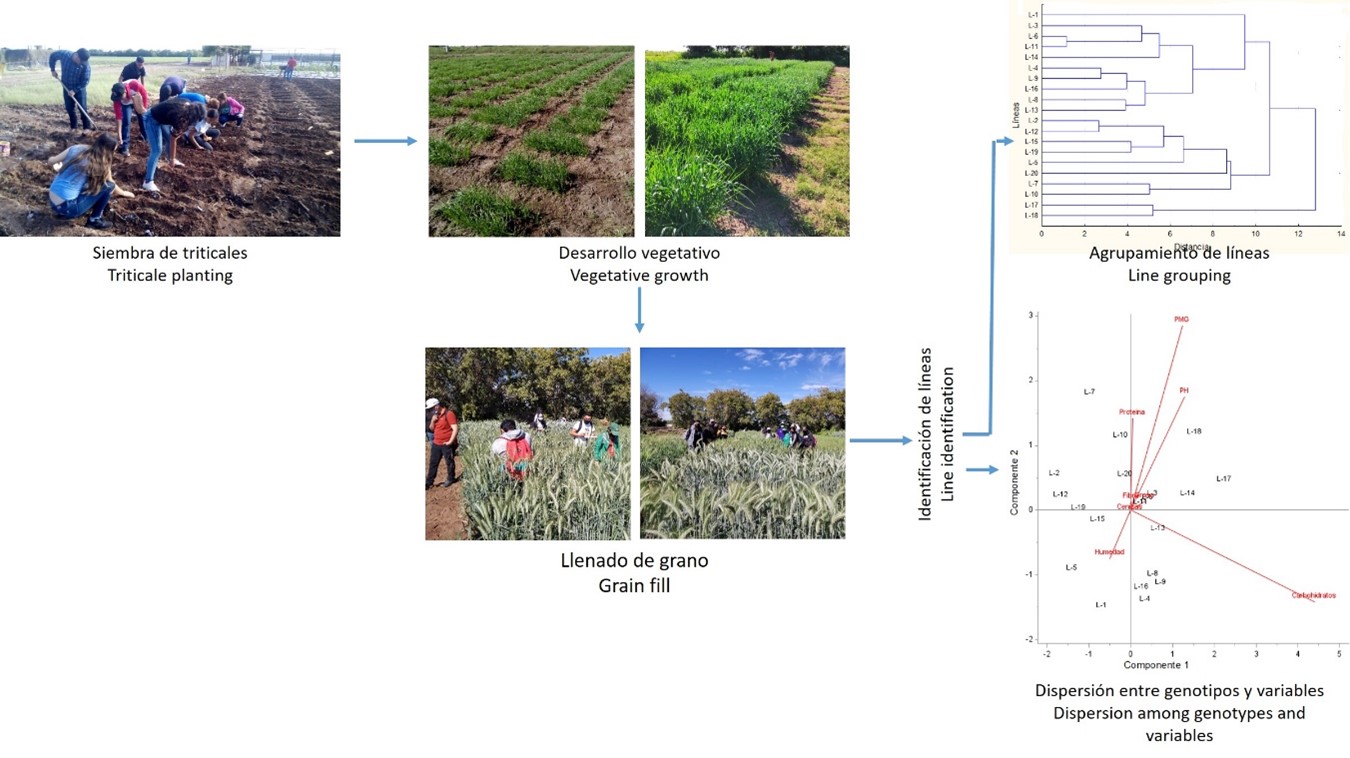Nutritional composition in triticales (X. Triticosecale Wittmack) grains and food uses
Nutritional composition of triticales food
DOI:
https://doi.org/10.18633/biotecnia.v25i2.1892Keywords:
X. Triticosecale Wittmack, physicochemical properties, industrial qualityAbstract
The need to investigate and evaluate the alternative of producing triticale in Mexico, to later incorporate it into the agri-food chain for human consumption is important, due to its good protein content (around 20 % more than wheat), added to the better balance of amino acids and its grain is richer in phosphorus than wheat grain. The objective of this research was to identify lines of triticales (X. Triticosecale Wittmack) based on the physical and chemical properties of the grain with value for the food industry. Twenty elite lines of spring triticales from the CIMMYT (Centro Internacional de Mejoramiento de Maíz y Trigo) research program were evaluated. The study was carried out in 2018 in Celaya, Guanajuato, Mexico, the experiment was randomized in a completely randomized experimental design with six repetitions, each experimental unit was each line, the variables measured were: thousand grain weight (PMG) hectoliter weight (PH), humidity, ashes, fat, fiber, protein and carbohydrates were determined in the food analysis laboratory of TecNM-Roque. The results showed statistical differences between lines; higher contents of PMG (45.85 g), PH (78.8 Kg hL-1) were found in L-18 and L-20 respectively, in fat, fiber, carbohydrate proteins the lines L-17, L-18 and L-20 obtained higher averages, in ash 75 % of the lines showed values lower than 2.0 %.
Downloads
References
American Association of Cereal Chemists. 1995. Official methods of Analysis. 10 th ed. Washington.
Aisawi, K., M. Reynols., R. Singh., M. Foulkes. 2015. The physiological basis of the genetic progress in yield potential of CIMMYT spring wheat cultivars from 1966 to 2009. Crop Sci. 55(4): 1749-1764.
Association of official analytical chemists. 2000 Official methods of Analysis. 15 th ed. Washington.
Association of official analytical chemists 2012. Official methods of Analysis. 15 th ed. Washington.
Ammar, K., Mergoum, M and Gomez M.H. 2004. The history and evolution of triticale, the triticale improvement and production. Food and Agriculture Organization of the United Nations (FAO), Rome, Italy.
Castaño, M., P. Ribotta., V. Ferreira., E. Grassi., A. Ferreira., H. di Santo., E. Castillo., y H. Paccapelo, 2015. Aptitud de las harinas integrales de triticales (x Triticosecale Wittmack) para la elaboración de galletitas. SEMIÁRIDA Rev. Facultad de Agronomía, UN La Pampa 25(1):25-39
Crossa, J. 1990. Statistical analysis of multilocation trials. Adv. Agron. 44:55–85.
Fan, Z. Triticale. 2018. Nutritional composition and food uses. Food Chemistry, February. 14, 241: 468-479.
Ferreira, V., E. Grassi., A. Ferreira., H. di Santo., E. Castillo, y H. Paccapelo, 2015. Triticales y tricepiros: interacción genotipo-ambiente y estabilidad del rendimento de grano. Chilean J. Agric. Anim. Sci. 31(2):93-104
García, E. 1973. Modificaciones al Sistema de Clasificación Climática de Köppen.
Giunta, F., Motzo, R., Virdis, A., A Cabigliera. 2017. The effects of forage removal on biomass and grain yield of intermediate and spring triticales. Field Crops Research 200: 47-57.
Gulmezoglu, N., O. Alpu and E. Ozer. 2010. Comparative performance of triticale and wheat grains by using path analysis. BJAS, 16 ;443-453
Jing, J.W., Guang L., Yan, B. Huang., Qiao, H. Zeng., Guo, S. S., Yi, H., Lin, Li., Song Q.S. 2016. Role of N-terminal domain of HMW 1Dx5 in the functional and structural properties of wheat dough. Food Chemistry. 213: 682-690.
Mergoum M, Singh PK., Peña RJ. 2009. Triticale: a “new” crop with old challenges. In: Carena MJ (ed) Cereals. Springer, New York. 267–287.
Moiraghi, M., Vanzetti L., Bainotti C., Helguera M, Leon., Perez, A.G. 2011. Relationship between soft wheat flour physicochemical composition and cookie-making performance. Cereal Chemistry 88(2): 130–136.
Negash, A.W., H. Mwambi, T. Zewotir., and G. Taye. 2013. Additive main effects and multiplicative interactions model (AMMI) and genotype main effect and genotype by environment interaction (GGE) biplot analysis of multi-environmental wheat variety trials. African Journal of Agricultural Research 8(12):1033-1040.
Núñez C.A.C., Escobedo L.D. 2011. Uso correcto del análisis clúster en la caracterización de germoplasma vegetal. Revista Agronomía Mesoamericana Vol. 22 (2): 415-427.
Oliete, B., G. Pérez., M. Gómez., P. Ribotta., M. Moiraghi., and A. León. 2010. Use of wheat, triticale and rye flours in layer cake production. J. Food Sci. and Tech. 45(4):697- 706.
Peña, B.R.J., N. Hernández E., P. Pérez H., H.E. Villaseñor M., M. Gómez V., A. Mendoza L. 2007. Calidad de la cosecha de trigo en México; ciclo otoño-invierno 2006-2007. Publicación Especial del CONASIST-CONATRIGO. 24 p
Pattison, L.A., Appelbee M., and Trethoman R.M. 2014. Characteristics of modern triticale quality: Glutenin and scalin subunit composition an mixiograph propierties. J. Agric. Food. Chem 62 (21), 4924-4931.
Pomortsev, A.V., N. Dorofeev, V., Y. Zorina, S., N. Katysheva, B., L. Sokolova, G. 2019. The effect of planting date on Winter rye and triticale overwinter survival and yield in Eastern Siberia. IOP Conf. Ser.: Earth Environ. Sci. 315 042031. AGRITECH. 5 pp.
Pruska, K.A., Makowska A., and Kedzior Z. 2017. Rheological characterisation of gluten from triticale (x Triticosecale Wittmack). Journal of the Science of Food and Agriculture. Vol. 97 (14): 5043-5052.
Jonnala, R.S., Macritchie, F., Herald, T.J., Lafiandra, D., Margiotta, B. and Tilley, M. 2010. Protein and quality characterization of triticale translocation lines in bread making. Cereal Chemistry. 87(6):546-552.
Riasat, M., Kiaani S., Saed M.A. and Mohamed P. 2019. Oxidant related biochemical traits are significant indices in triticale grain yield under drought stress condition. Journal of Plant Nutrition 42(2): 111-126.
Zhu, F. 2018. Triticale: Nutricional composition and food uses. Food Chemistry. 241: 468-479.

Downloads
Published
How to Cite
Issue
Section
License
Copyright (c) 2023

This work is licensed under a Creative Commons Attribution-NonCommercial-ShareAlike 4.0 International License.
The journal Biotecnia is licensed under the Attribution-NonCommercial-ShareAlike 4.0 International (CC BY-NC-SA 4.0) license.
















_(2).jpg)







